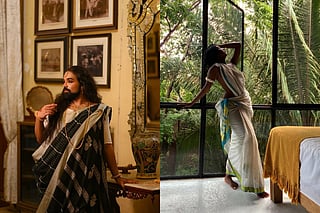- HOMEGROWN WORLD
- #HGCREATORS
- #HGEXPLORE
- #HGVOICES
- #HGSHOP
- CAREERS
- ABOUT US
- CONTACT US

As a child, I revered sarees. Yards of fabric neatly draped and folded over, flowing over someone’s arm like a waterfall; I felt that they made the women in my family look like goddesses. But as I entered my teens and my interests grew increasingly alternative, I started to feel a resistance towards sarees. They were an embodiment of the traditional, and while I continued to love how they looked on the older women in my family, I didn’t feel confident with them on my body. Back then, I thought of anything traditional as boring and felt confined at the thought of being wrapped and pinned in those swaths of cloth.
Today, however, I’ve come to learn that my perception of the traditional as mundane could not be more wrong. Despite their long history across the subcontinent, sarees could never go out of style. Sarees are so iconic because of their versatility– there’s truly no limit to the many different ways they can be draped. Their beauty lies in the craftsmanship of their makers and the innovation of their wearers. With the internet, we have access to a million different ways we can style our sarees. From Pinterest inspo pics to draping tutorials, there’s endless inspiration you can use to transform your traditional saree. Three creators, in particular, caught our eye with the way they break the mould through their saree styling:
Mohini Basu is a Bengali influencer reinventing the saree. When she isn’t working towards her PhD, Basu is inspiring her large Instagram following with her unconventional yet still traditional Indian fashion. Using elaborate draping and pinning techniques, Basu rose to popularity by reimagining sarees in the styles of high fashion designers like Vivienne Westwood and Schiaparelli. Her work is proof that traditional Indian wear cannot be confined to any one style, styling sarees with a cool, edgy flair that would make my middle school self’s heart sing.
Check her out here.
Pushpak Sen, also known as The Bong Munda, proves that anyone who thinks clothes should be limited to any one specific gender is, to put it frankly, just boring. The stylist is known for his sartorial exploration and wears sarees with pride, social expectations be damned. He told Telegraph India that when he first started wearing sarees, he would fold the cloth in the style of a dhoti. But as Sen continued his stylistic experimentation, he realized that draping was the only differentiating factor between the socially acceptable dhoti and the supposedly unacceptable saree. Sen has freed himself from the confines of gender expectations and showed us all that we can embrace our customary garb while still staying true to ourselves.
Check him out here.
To Natasha Thasan, saree draping has become an act of therapy. The fashion influencer-turned-business owner started playing with sarees at a young age, finding comfort in through her cultural and creative expression. The influencer told Narcity Toronto that she takes inspiration from global cultures when configuring new saree draping styles, thereby transforming traditional Indian attire with a globalised outlook. Today, Thasan’s draping tutorials have helped her amass over 420 thousand followers on Instagram and led to the creation of her brand, Drape Therapy. Her tutorials encourage people around the world to experiment with their style, teaching us all that there is no one way to wear a saree.
Check her out here.
Sarees are one of the world’s most iconic garments because they hold infinite possibilities. Unlike dresses or even other Indian attire like ghagras, they have no set design– the wearer holds complete power in how they would like to present themselves. This is your sign to play with the saree and remain unconfined by expectations, whether social or sartorial.
Click here to follow Mohini Basu, The Bong Munda, and Natasha Thasan.
If you enjoyed reading this, here’s more from Homegrown:
The Secret Of ‘Maachh-er Tok’: A Light, Sweet & Sour Bengali Summer Fish Stew
Mrinmai Arun's Modular Jewellery Blends Her Diasporic Roots With Modern Flourishes
Homegrown Game Studios Are Building A Bridge To Authentic Cultural Representation
